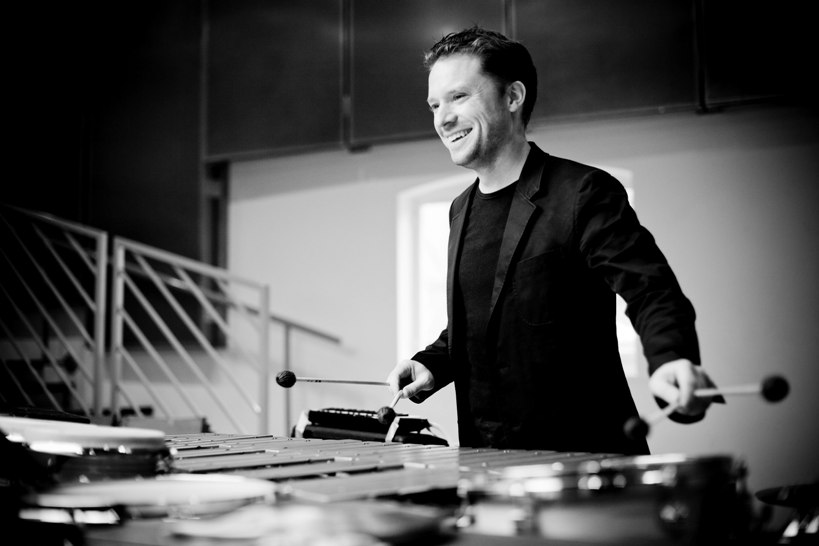Stefanovich, Currie, Queen Elizabeth Hall | reviews, news & interviews
Stefanovich, Currie, Queen Elizabeth Hall
Stefanovich, Currie, Queen Elizabeth Hall
Dream team for Birtwistle, while the pianist shines in Ligeti and Messiaen

Tamara Stefanovich and Colin Currie – a dream team for Birtwistle’s The Axe Manual. Both are new music specialists with a gift for grace and dexterity, even in the most complex works. The score sets up a range of sophisticated relationships between piano and percussion, from sympathetic resonances to complex interplays of stretto and hocket. Yet none of this fazes the two players, nor ever challenges their close ensemble, seemingly telepathic in its precision.
The percussion setup is based around a large marimba, with a collection of mostly untuned instruments arranged at either side. Birtwistle makes extreme demands for doubling: for example, the two sticks held in the left hand are often required to play both the bass notes of the marimba and a drum positioned to the side. The work is in a single 25 minute span, but is sectional, with the percussionist moving from one playing position to another every few minutes.
 Colin Currie’s confident and unhurried movements (the percussionist pictured right by Marco Borggreve) gave the music an air of logic and natural flow, in marked contrast to the unpredictable and often erratic rhythms that he was actually playing. Stefanovich worked closely with Currie, occasionally a little too subservient, dropping from duo partner to accompanist. Yet the sophistication she brought to the music was impressive, especially in sections where timbres from the percussion are reflected in the piano, requiring a broad range of colours and attacks.
Colin Currie’s confident and unhurried movements (the percussionist pictured right by Marco Borggreve) gave the music an air of logic and natural flow, in marked contrast to the unpredictable and often erratic rhythms that he was actually playing. Stefanovich worked closely with Currie, occasionally a little too subservient, dropping from duo partner to accompanist. Yet the sophistication she brought to the music was impressive, especially in sections where timbres from the percussion are reflected in the piano, requiring a broad range of colours and attacks.
Stefanovich had the second half to herself, with performances of Messiaen and Ligeti. The previous evening, we heard Pierre-Laurent Aimard performing Birtwistle and Messiaen, and the comparison was instructive. Where Aimard is rhythmically incisive with clear, focused sonorities, Stefanovich instead emphasises line and flow. Her tone is warmer – rounder and less crystalline. Yet she is just as able to articulate Messiaen’s complex rhythms and often heavily accented attacks.
Cantéyodjayâ is a virtuosic showpiece, even by Messiaen’s standards. Its irrational rhythms, derived from Indian classical music, are impossible to second guess, yet sounded intuitively logical under Stefanovich’s hands. The two “Ile de feu” movements from Quatre études de rythme are stamping dances inspired by the native people and volcanic landscapes of Papua New Guinea. All those earthy rhythms and pounding accents came through well, and without Stefanovich ever compromising the flow of her phrases or the evenness of her articulation.
The sheer playfulness of these works was beautifully expressed
Ligeti’s Etudes are now central to the modernist piano repertoire, but are rarely performed with the agility or grace we heard here. Stefanovich selected eight, forming a roughly chronological sequence that also increased in complexity from one work to the next. The sheer playfulness of these pieces was beautifully expressed, for instance the dispute between the hands in "Touches bloquées", where the fingers of the left impotently strike notes already held down by the right, and the nervous, filigree opening of "Der Zauberlehrling", where the music seems trapped in its repeated opening motif, unable, or unwilling, to continue.
The sequence ended with a mighty showpiece, "L’escalier du diable", the most diabolically complex of Ligeti’s solo piano works. Any notions of reticence or reserve from Stefanovich were shed here, as she delivered a stunning, bravura performance. A spectacular conclusion to an impressive recital.
rating
Share this article
The future of Arts Journalism
You can stop theartsdesk.com closing!
We urgently need financing to survive. Our fundraising drive has thus far raised £49,000 but we need to reach £100,000 or we will be forced to close. Please contribute here: https://gofund.me/c3f6033d
And if you can forward this information to anyone who might assist, we’d be grateful.

Subscribe to theartsdesk.com
Thank you for continuing to read our work on theartsdesk.com. For unlimited access to every article in its entirety, including our archive of more than 15,000 pieces, we're asking for £5 per month or £40 per year. We feel it's a very good deal, and hope you do too.
To take a subscription now simply click here.
And if you're looking for that extra gift for a friend or family member, why not treat them to a theartsdesk.com gift subscription?
more Classical music
 Kempf, Brno Philharmonic, Davies, Bridgewater Hall, Manchester review - European tradition meets American jazz
Bouncing Czechs enjoy their Gershwin and Brubeck alongside Janáček and Dvořák
Kempf, Brno Philharmonic, Davies, Bridgewater Hall, Manchester review - European tradition meets American jazz
Bouncing Czechs enjoy their Gershwin and Brubeck alongside Janáček and Dvořák
 Solomon, OAE, Butt, QEH review - daft Biblical whitewashing with great choruses
Even a top soprano and mezzo can’t make this Handel paean wholly convincing
Solomon, OAE, Butt, QEH review - daft Biblical whitewashing with great choruses
Even a top soprano and mezzo can’t make this Handel paean wholly convincing
 Two-Piano Gala, Kings Place review - shining constellations
London Piano Festival curators and illustrious friends entertain and enlighten
Two-Piano Gala, Kings Place review - shining constellations
London Piano Festival curators and illustrious friends entertain and enlighten
 Echo Vocal Ensemble, Latto, Union Chapel review - eclectic choral programme garlanded with dance
Beautiful singing at the heart of an imaginative and stylistically varied concert
Echo Vocal Ensemble, Latto, Union Chapel review - eclectic choral programme garlanded with dance
Beautiful singing at the heart of an imaginative and stylistically varied concert
 Scott, Irish Baroque Orchestra, Whelan, RIAM, Dublin review - towards a Mozart masterpiece
Characteristic joy and enlightenment from this team, but a valveless horn brings problems
Scott, Irish Baroque Orchestra, Whelan, RIAM, Dublin review - towards a Mozart masterpiece
Characteristic joy and enlightenment from this team, but a valveless horn brings problems
 Classical CDs: Voice flutes, flugelhorns and froth
Baroque sonatas, English orchestral music and an emotionally-charged vocal recital
Classical CDs: Voice flutes, flugelhorns and froth
Baroque sonatas, English orchestral music and an emotionally-charged vocal recital
 Kanneh-Mason, Britten Sinfonia, Shave, Milton Court - a grin and a big beaming smile
A pair of striking contemporary pieces alongside two old favourites
Kanneh-Mason, Britten Sinfonia, Shave, Milton Court - a grin and a big beaming smile
A pair of striking contemporary pieces alongside two old favourites
 theartsdesk at the New Ross Piano Festival - Finghin Collins’ musical rainbow
From revelatory Bach played with astounding maturity by a 22 year old to four-hand jazz
theartsdesk at the New Ross Piano Festival - Finghin Collins’ musical rainbow
From revelatory Bach played with astounding maturity by a 22 year old to four-hand jazz
 First Person: Manchester Camerata's Head of Artistic Planning Clara Marshall Cawley on questioning the status quo
Five days of free events with all sorts of audiences around Manchester starts tomorrow
First Person: Manchester Camerata's Head of Artistic Planning Clara Marshall Cawley on questioning the status quo
Five days of free events with all sorts of audiences around Manchester starts tomorrow
 Goldscheider, Brother Tree Sound, Kings Place review - music of hope from a young composer
Unusual combination of horn, strings and electronics makes for some intriguing listening
Goldscheider, Brother Tree Sound, Kings Place review - music of hope from a young composer
Unusual combination of horn, strings and electronics makes for some intriguing listening

Add comment